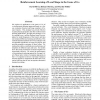Free Online Productivity Tools
i2Speak
i2Symbol
i2OCR
iTex2Img
iWeb2Print
iWeb2Shot
i2Type
iPdf2Split
iPdf2Merge
i2Bopomofo
i2Arabic
i2Style
i2Image
i2PDF
iLatex2Rtf
Sci2ools
IJCAI
2007
2007
Reinforcement Learning of Local Shape in the Game of Go
We explore an application to the game of Go of a reinforcement learning approach based on a linear evaluation function and large numbers of binary features. This strategy has proved effective in game playing programs and other reinforcement learning applications. We apply this strategy to Go by creating over a million features based on templates for small fragments of the board, and then use temporal difference learning and self-play. This method identifies hundreds of low level shapes with recognisable significance to expert Go players, and provides quantitive estimates of their values. We analyse the relative contributions to performance of templates of different types and sizes. Our results show that small, translation-invariant templates are surprisingly effective. We assess the performance of our program by playing against the Average Liberty Player and a variety of computer opponents on the 9×9 Computer Go Server. Our linear evaluation function appears to outperform all other...
Artificial Intelligence | IJCAI 2007 | Linear Evaluation Function | Reinforcement Learning | Reinforcement Learning Approach |
| Added | 29 Oct 2010 |
| Updated | 29 Oct 2010 |
| Type | Conference |
| Year | 2007 |
| Where | IJCAI |
| Authors | David Silver, Richard S. Sutton, Martin Müller 0003 |
Comments (0)

